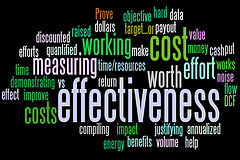
There is typically a lot of anxiety around the launch of an event measurement project. Typically the stakeholders have… well… a lot at stake. They’re embarking on a process that they probably don’t entirely understand that will result directly in an evaluation of how well they’re doing their job. This is scary. Kudos to them for taking it on. Most shy way from such an effort.
If you’re going to have any role in launching the initiative you have to be overly sympathetic to this. What you measure needs to be carefully considered.
How you prep and update the team is equally as important. And when you find information that is less than favorable, you have to deliver it with soft gloves if you hope ever use it to have an impact.
What Event Marketing Metrics Matter?
There are a lot of things you can target when considering what to measure for event marketing. We’d suggest you keep the following guidelines in mind.
First, don’t measure what you don’t have a clear plan for. Otherwise said, if you don’t know exactly how you’ll use the information, don’t waste time collecting the data.
Have a plan for what you want to do with the results before you start scripting survey questions or laying out what MainEvent field staff recap reporting variables you’re going to use.
Here’s another suggestion, don’t ask questions that evaluate people. They are rarely useful outside of HR processes and should probably be left to the HR professionals.
And really, what are you going to gain from asking people if they “liked the event?” or if they thought the staff you had onsite were “friendly?”
Instead, ask if they plan to buy the product or if they had bought the product before. This will give you much more and will be a whole lot easier to use.
Updating a Project Team on Event Measurement
Don’t leave the stakeholders in the dark. Start by outlining what the measurement milestones will be and provide a rough calendar for when you’ll be delivering on those milestones. Give this to the stakeholders so they know what to expect and when.
And don’t wait until things are over to share the data. Too much risk. Provide the team with updates during the event marketing program so they can see where things are trending and what the averages are.
If things are going pair-shaped let everyone know early on so they have the chance to help fix things. Don’t wait until it’s all over and there is nothing that can be done.
Know How to Deliver Bad Event Marketing ROI News
Whether it’s average consumer engagements per event, purchase intent, or return-on-investment… these may, on the surface, look damaging. Don’t shy away from this. It’s in the constructive feedback that we learn how to improve. But it has to be constructive.
The best way to look at data that is hard to look at is to segment it until you find the good story components.
Take ROI, for example. Let’s say your overall program is posting a 89% ROI. That’s negative. For every dollar spent you returned $0.89 in value to the brand (or lost $0.11 in value).
However, if you can segment ROI and show that when the team was at a state fair, they delivered $1.94 in value (a 194% ROI); and when they were doing street intercepts, the program gave the brand a $0.41 return, then that’s kind of exciting.
It tells you that while the overall number was low, if they had just done more state fairs they would have seen a wildly positive return. This builds hope, provides direction, and is actionable.
This is why you measure.
Photo Source: https://www.flickr.com/photos/cambodia4kidsorg/
